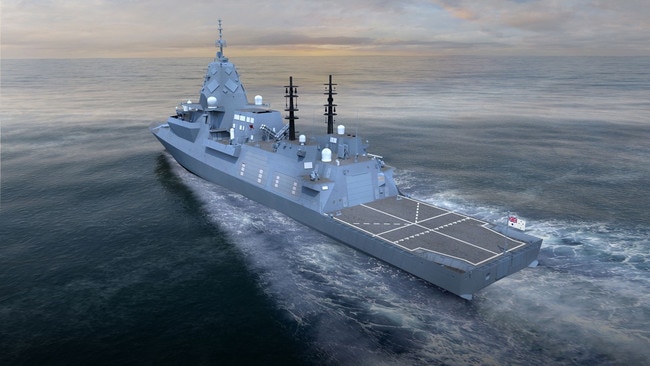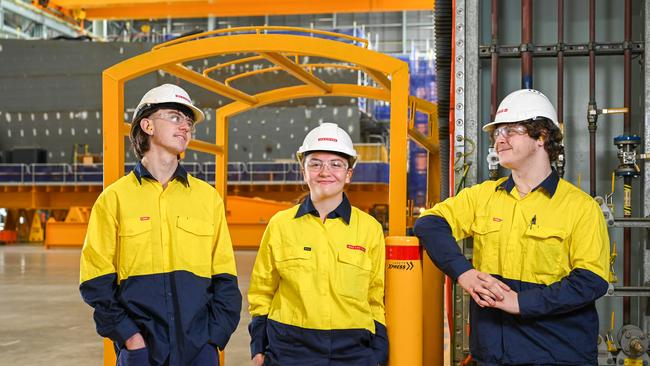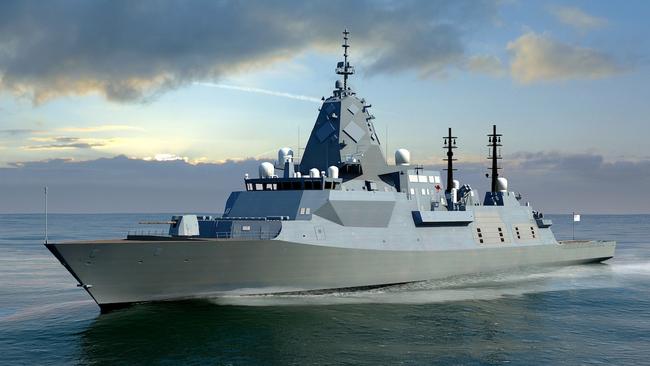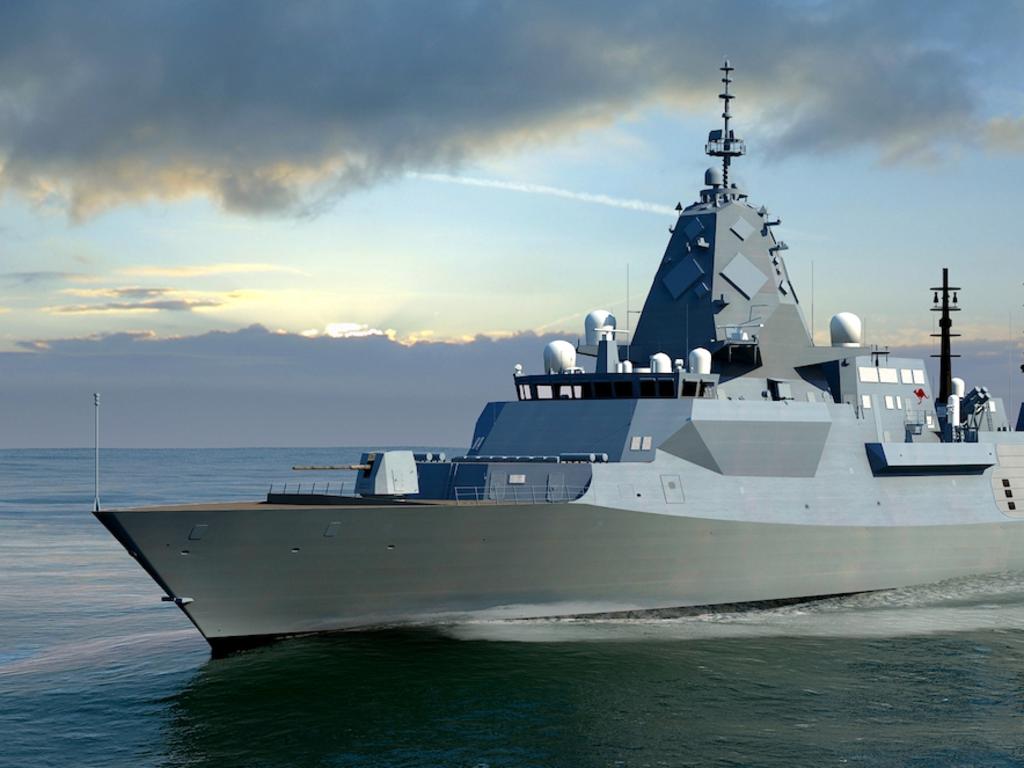The $45 billion Hunter Frigates Project has been a comedy of errors from day one
It was supposed to be the futuristic warship that would help Australians sleep soundly at night. In truth, it’s been a comedy of errors from day one.

It was the futuristic warship that would help Australians sleep soundly at night. In the words of the Turnbull government in 2018 the new Hunter-class frigate would “provide our nation with one of the most advanced anti-submarine warships in the world that will underpin our security for decades to come”.
Five years on, the Hunter-class frigates built by BAE Systems, are in grave danger of being pulped before they are built as the Albanese government weighs whether to commit more than $45bn of taxpayer money into a warship that many experts say is a lemon.
We won’t know until after the results of an independent review into the navy’s future surface fleet whether the government will persevere with the plan to build nine Hunter frigates in Adelaide, or reduce the program to six boats or to three or scrap it entirely.
But already the Hunter project – the largest naval shipbuilding project in the nation’s history – is being seen as a textbook example of how to torpedo a new warship through recklessness, mismanagement, unaccountability and hubris.
The fact that the authors of the recent Defence Strategic Review (DSR), former Defence chief Angus Houston and former defence minister Stephen Smith, were highly critical of the Hunter project begs the question of what happened to derail such a historic national enterprise.
The short answer is almost everything. The mistakes of the Hunter-class project span three prime ministers, five defence ministers, two defence secretaries, two chiefs of Defence and three chiefs of navy. At every turn, the Hunter frigate project has been plagued by mistakes that began in a fateful meeting of the top brass in Canberra in February 2016.
In that meeting a group called the Defence Capability and Investment Committee, which comprised the chiefs of the services, senior Defence officials including the Defence secretary, discussed which new frigate the navy should acquire.
The 2009 and the 2016 defence white papers had foreshadowed that the navy would acquire eight new frigates that would be larger than the current Anzac-class vessels and quipped “with a strong emphasis on submarine detection”.

The government demanded that the new frigates be a mature military-off-the-shelf design, in other words, a proven design that would cause minimal development problems.
At the February 2016 meeting the top brass looked at four potential frigate contenders. The first two, an Italian FREMM (multi-purpose frigate) and a modified Spanish F-100 were mature designs with the FREMMS in service in Italy and the F-100 a derivative of the existing Hobart-class air warfare destroyers in Australia.
The meeting agreed that these two warships were “the most viable designs”. But the group needed a third contender, so they decided that the third option would be either a French FREMM – which was also in service already – or a yet-to-be built futuristic British frigate design called the Type 26. The Type 26 is the base reference ship for the Australianised Hunter-class frigates.
Unlike the other three contenders, the Type 26 was clearly the most high-risk option because it was still in development but it also had – on paper at least – the best Anti-Submarine Warfare (ASW) capability of the four, which the government said was a priority capability. But the Type 26 was also virtually unarmed compared with other large warships. It was an ASW specialist ship so it had only 32 missile cells compared with 48 for the navy’s existing AWDs and 96 for the US Navy’s Arleigh Burke-class destroyers.
At that stage the Type 26 was the least likely of the four contenders because it was such high risk. Yet as the selection process continued, the Type 26 mysteriously replaced the French FREMM as the third contender.
But when the Australian National Audit Office released a report on the Hunter project last month, it found Defence had “not retained” the records that explained that decision.
From this point, a series of Fawlty Towers-style missteps led to the Type 26 going from being the least likely warship to being the chosen one for Australia.
Firstly, and incredibly, the three frigate options were assessed entirely according to capability with no account as to whether each option provided “value for money”. This was not only contrary to Defence procurement guidelines but also – given the eye-watering money involved – it was a callous disregard for the Australian taxpayer.
“Contrary to the requirements of the Commonwealth Procurement Rules, a value for money assessment had not been conducted by Defence,’ the ANAO said.
If it had, the Type 26 might easily have been ruled out because – as a ship still in development – it was by far the highest risk of blowing its budget, a fate that has since come to pass.
Defence then made two more astonishing mistakes that artificially propelled the Type 26 to outright favouritism for Australia’s choice of frigate.
The first was to swallow British claims that the design of the Type 26 was more mature than it actually was and that the high-risk project was “on track” when in fact it was about to be mired to delays in British shipyards.
Then incredibly, and contrary to the facts, Defence advised the government that the Type 26 was in fact a “mature” design. Defence did not do any assessment to test this claim.
This lie was called out early last year by the Independent Assurance Review, which stated “The Type 26 was not a mature Reference Ship Design (and) has matured much more slowly than anticipated”.

In January this year the Surface Ships Advisory Committee report stated that “when the government selected the BAE Systems Type 26 as the Reference Ship Design it was clearly understood that they were selecting an approach that was highest in risk”.
By early 2018, the refusal of Defence to assess either value for money or the maturity of the design and the risks inherent in each, naturally led to the Type 26 becoming the favoured design.
But then – shortly before the design was actually selected in early 2018 – Defence made another fundamental mistake. It knew that the Type 26 would need to be “Australianised” to include the Australian-developed CEA Phased-Array Radar and the US Navy’s Aegis combat management system and US weapons.
But for reasons that have not been properly explained, Defence failed to fully and accurately account for the extra weight that these major modifications would add to the Australian version of the Type 26, the Hunter class.
As a result, the Hunter design has now jumped from a full displacement weight of 8800 tonnes to 10000 tonnes, giving it a margin for growth of only 3.3 per cent, a margin that is considered too small by many experts to allow for future defence systems to be incorporated onto the ship. It is incredibly difficult to make a warship lighter without compromising its effectiveness.
Not surprisingly these problems of excess weight and immature design have come back to haunt the project.
In June 2021 an 18-month delay was announced on the start of construction on the first ship. The ANAO audit report last month said the project had been delayed by a further 18 months, pushing the completion of the first frigate from earlier 2031 to mid-2032, with the last of nine ships due in the mid-2040s.
Since the Hunter class was selected in 2016 the cost of the project has risen from $35bn to $45bn, with the ANAO report warning that as of January “‘the project was forecast to exceed the whole of the project budget approved by the government by a significant amount”. Defence says it cannot say exactly what the new budget of the project will be.
The Hunter project has also been unlucky because as it has progressed, the strategic priorities of the government have shifted from its specialised ASW capabilities towards warships with enhanced missile firepower.
The DSR talks about the “missile age” and calls for a surface fleet with “enhanced lethality” and better long-range strike capability. In other words, everything that the Hunter frigate is not. The DSR also hints at fewer large warships, saying the future fleet should be a better mix of large “tier 1” warships (like frigates and air warfare destroyers) and smaller “tier 2” warships (like corvettes).
The DSR also contains words that are deliberately aimed at the debacle of the Hunter process, saying that Defence officials must no longer “indulge in the quest for perfectionism” but must instead focus on “getting (capability) into service without delay and achieving value for money”.
The possible survival of the Hunter project, despite its faults, is helped by the fact that the government has committed politically to a continuous naval shipbuilding program in Osborne and in Henderson in Western Australia. Continuous shipbuilding has never been achieved in Australia, but if successfully implemented it would generate permanent jobs and bring down the cost of building each warship.
This promise means that if the government scraps the Hunter build at Osborne it will need to replace it quickly with another shipbuilding project.
This is not impossible. The Hunter project could be replaced by another program that generates continuous shipbuilding, for example by building more air warfare destroyers or smaller corvettes at Osborne. The members of the three-person independent review team have met rival shipbuilders such as Spain’s Navantia to explore alternatives to the Hunter project.
The Surface Ships Advisory Committee said in a report in January that it believed the importance of the Hunter project in providing continuous shipbuilding justified pushing on regardless of the problems so far.
“The SSAC considers that the Hunter-class frigate program is a viable yet still high-risk program that is the foundation for Continuous Naval Shipbuilding in Australia and thus our recommendation is to stay the course,” it said.
The Albanese government is keenly aware of the tricky politics of the Hunter project. Any decision to scrap the project entirely would anger the British government, which stands to be richly rewarded by the program. It would also seem, at first blush, to be at odds with the closer co-operation flagged under the three-nation AUKUS agreement.
But the announcement of the AUKUS nuclear submarine path in March delivered an enormous unexpected boon for the British defence industry, with the announcement that a British-designed joint AUKUS submarine would be built in Adelaide.
That was such a big win for London, that Australia could feasibly cut the Hunter project without anything like the diplomatic fallout that occurred when the French submarine contract was ripped up.
This is not to say that the Hunter project is doomed, but there is no doubt that it has had a nightmare birth. Rather than make a hasty decision about such a major enterprise the government has called for the independent review of the fleet headed by former US vice-admiral William Hilarides, which will report by the end of September. That report is likely to determine whether the Hunter project survives. If it does, it will have survived despite Defence’s serial mismanagement of the project that has proved to be a bigger threat to the Hunter frigates than the Chinese navy.








To join the conversation, please log in. Don't have an account? Register
Join the conversation, you are commenting as Logout